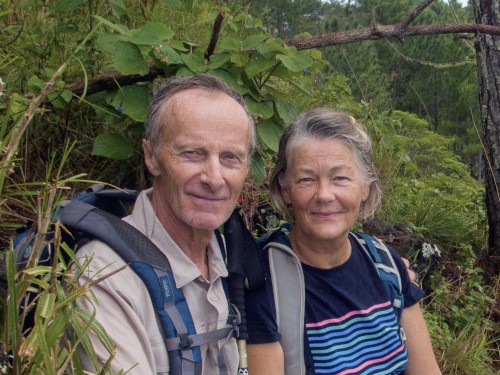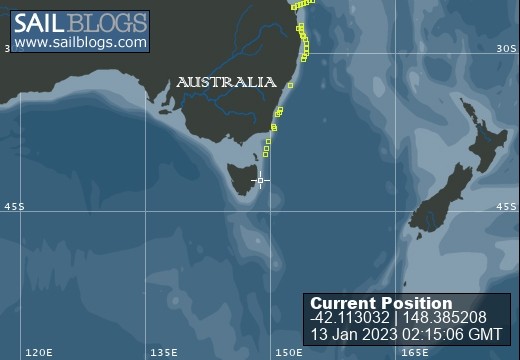
Leela Year Six - Across the Pacific
Well.... to our own surprise here we are
17 May 2022 | Vuda Marina, Lautoka, Fiji
26 January 2022 | Australia
08 November 2021 | Viti Levu, Fiji
02 September 2021 | Paradise Resort, Taveuni
29 August 2021 | Paradise Resort, Taveuni, Fiji
10 August 2021 | Western S Pacific
19 June 2021 | New Jersey
14 March 2021 | At sea
05 March 2021 | Raroia, Tuamotus
05 February 2021 | Raivavae, The Australs Group, French Polynesia
04 February 2021 | Raivavae, The Australs Group, French Polynesia
17 January 2021 | Tahiti
13 December 2020 | Papeete, Tahiti
14 November 2020 | Pape’ete, Tahiti
14 November 2020 | Tahiti
01 October 2020 | Fakarava
24 September 2020 | Fakarava South Pass
19 August 2020 | Papeete, Tahiti
02 August 2020 | Pape’ete, French Polynesia
09 July 2020 | Papeete, Tahiti
The Passage Making Setup
23 August 2019 | Nuku Hiva
Graham
For the long downwind passage we used a modified Twizzle or Simbo rig
This consists of two genoas on the furler that can either be deployed 'wing on wing' or used as a single genoa with the sails laid on top of one another. Normally it requires twin poles that we do not have so we used the pole on the upwind side and the boom on the downwind side. This worked fine but prevented us using the main in conjunction with the genoas. If I did it again I might try not using a pole on the downwind side and incorporating the reefed main. It is well described in the attached article.
The setup worked very well. We went several days reaching with the sails laid on one another without problem then switched to the downwind setup. It was fast and could be reefed by one person from the cockpit very quickly. The boat was well balanced, despite the different sized genoas and showed no tendency to broach, even at the occasional 10kts, although we still needed warps to deal with the aft quartering seas (more on that later). Despite the benefits I remain somewhat ambivilant.
It put enormous strain on the furler and furling line, enough to destroy most of the furler line running blocks. We have an oversized furler system that seems none the worse for the trip but it felt like unnecessary risk at times. As we had configured it, the operating window was from Port 120deg to Starboard 160deg which happened to work OK for us but got tight. With the boom and the pole out it was not a trivial job to reconfigure for broad reaching.
The Hydrovane was remarkably effective, even downwind in difficult conditions. I was expecting to get it set up and tested then put it away for emergencies but we ended up using it most of the way. It was subtle but it actually seemed to provide a smoother ride than the very sophisticated autopilot. The only time it was insufficient was when we needed to sail close to the edge of the working envelope of the rig. The Hydrovane did not hold us to the angle tightly enough causing the sails to flog. Using both the autopilot and the Hydrovane together worked well in those circumstances although care was needed to make sure they worked together and did not fight one another.
In big following seas (most of the passage) we trailed warps to help keep the stern in line when surfing off wave faces. This consisted of 109' of 3/4" nylon anchor rode, 10' of chain and a fender. Above 18kts it had no apparent effect on boat speed and may have been faster because it helped prevent the boat slewing sideways then rolling on the waves. Apart from being very uncomfortable, this sideways slide unbalances the sails. This use of warps made the Hydrovane more effective and also make the ride much more comfortable and (so far) has prevented boarding seas. It is pretty much our go to solution for following seas in anything over about 18kts true now.
We had very few equipment failures on the passage. The whisker pole went from being a telescopic long pole to being a fixed length short pole when the extension line broke. This meant we had to stay quite heavily reefed to keep the sail shape. Fortunately there was enough wind to make this necessary anyway. The furler line blocks were easily bypassed or replaced. The masthead light has gone intermittent. It is probably an electronics problem in the LED light but I will check the masthead connection when we get to flat water (SOON I hope). The SSB radio worked as well as ever (not at all....).
All in all we were very happy with Leela's performance. We were much faster than we anticipated. We were reasonably comfortable in the robust conditions and we got here pretty much in one piece. What more could you ask for?
This consists of two genoas on the furler that can either be deployed 'wing on wing' or used as a single genoa with the sails laid on top of one another. Normally it requires twin poles that we do not have so we used the pole on the upwind side and the boom on the downwind side. This worked fine but prevented us using the main in conjunction with the genoas. If I did it again I might try not using a pole on the downwind side and incorporating the reefed main. It is well described in the attached article.
The setup worked very well. We went several days reaching with the sails laid on one another without problem then switched to the downwind setup. It was fast and could be reefed by one person from the cockpit very quickly. The boat was well balanced, despite the different sized genoas and showed no tendency to broach, even at the occasional 10kts, although we still needed warps to deal with the aft quartering seas (more on that later). Despite the benefits I remain somewhat ambivilant.
It put enormous strain on the furler and furling line, enough to destroy most of the furler line running blocks. We have an oversized furler system that seems none the worse for the trip but it felt like unnecessary risk at times. As we had configured it, the operating window was from Port 120deg to Starboard 160deg which happened to work OK for us but got tight. With the boom and the pole out it was not a trivial job to reconfigure for broad reaching.
The Hydrovane was remarkably effective, even downwind in difficult conditions. I was expecting to get it set up and tested then put it away for emergencies but we ended up using it most of the way. It was subtle but it actually seemed to provide a smoother ride than the very sophisticated autopilot. The only time it was insufficient was when we needed to sail close to the edge of the working envelope of the rig. The Hydrovane did not hold us to the angle tightly enough causing the sails to flog. Using both the autopilot and the Hydrovane together worked well in those circumstances although care was needed to make sure they worked together and did not fight one another.
In big following seas (most of the passage) we trailed warps to help keep the stern in line when surfing off wave faces. This consisted of 109' of 3/4" nylon anchor rode, 10' of chain and a fender. Above 18kts it had no apparent effect on boat speed and may have been faster because it helped prevent the boat slewing sideways then rolling on the waves. Apart from being very uncomfortable, this sideways slide unbalances the sails. This use of warps made the Hydrovane more effective and also make the ride much more comfortable and (so far) has prevented boarding seas. It is pretty much our go to solution for following seas in anything over about 18kts true now.
We had very few equipment failures on the passage. The whisker pole went from being a telescopic long pole to being a fixed length short pole when the extension line broke. This meant we had to stay quite heavily reefed to keep the sail shape. Fortunately there was enough wind to make this necessary anyway. The furler line blocks were easily bypassed or replaced. The masthead light has gone intermittent. It is probably an electronics problem in the LED light but I will check the masthead connection when we get to flat water (SOON I hope). The SSB radio worked as well as ever (not at all....).
All in all we were very happy with Leela's performance. We were much faster than we anticipated. We were reasonably comfortable in the robust conditions and we got here pretty much in one piece. What more could you ask for?
Comments
| Vessel Name: | Leela |
| Vessel Make/Model: | Bristol 38.8 |
| Hailing Port: | Portsmouth, NH |
| Crew: | Graham and Janaki |
| About: | |
| Extra: |
Leela's Photos - Main
No items in this gallery.
About us

Who: Graham and Janaki
Port: Portsmouth, NH
